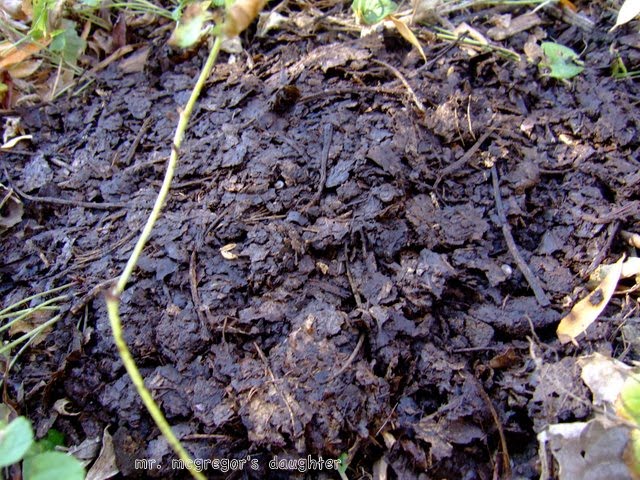
Every year it's the same thing, the neighbors stuff their leaves into bags and set them out at the curb to be picked up and taken to the municipal compost pile. This year, in a slight twist, by claiming to be environmentally responsible, the village has discontinued free leaf bags (they're having budget problems). So we've all had to buy the bags this year, despite the village's suggestion that residents compost their fallen leaves or put them in the Big Green Monster.I've bought leaf bags too, but only to store some of the leaves to use as winter mulch. I won't give away my precious leaves, oh no. While many gardeners wax poetically about the wonders of compost, I am enamoured of leaf mold.

Compost, which is pretty much anything that can rot, is the thing for feeding plants, but for improving the condition of soil, leaf mold, which is solely rotted leaves, is the best. I've posted about how my soil develops gaping cracks every summer, regardless of the amount of rainfall. Leaf mold is my weapon of choice against the clay that causes the cracks. It's also what native woodland plants want to grow in.
Making leaf mold is easy. If your leaves are small, thin, or not plentiful, leaving them where they fall in the garden is a good way to let nature make leaf mold. If, as in my garden, the leaves are large, thick or smothering the plants, the leaves should be removed, shredded and then returned.
For leaves fallen on the lawn or when there are too many to leave in the garden, the patient/lazy way to make leaf mold is just to pile up fallen leaves in an out of the way corner and let them rot for a couple of years. (While storing them in black plastic bags has been recommended, that's not an eco-friendly way to do it, as you end up with plastic bags that can't be reused.) That's too slow for me, and, besides, I'd run out of places to store them all within a year. Instead, I shred the leaves, either with the lawn mower or a leaf blower/vac set on vacuum mode (a chipper shredder would be ideal), then put the shredded leaves in a bin.

Depending on the weather, I can have usable leaf mold in a couple of months.
The bin is full to the brim in autumn, but by the end of winter, it has already broken down quite a bit. Then, as I remove the shredded leaf-mulch I've put down for winter protection, I put it in the leaf mold bin. The stuff on the bottom from the previous autumn is ready for use in the spring in beds and in container plantings, and by midsummer, much of what I added in spring is ready also. The last of the finished product in autumn is used to cover Sanguinaria, which invariable pushes itself up out of the ground, and as a top dressing over dormant spring ephemerals.

Not bad for something that grows on trees.
